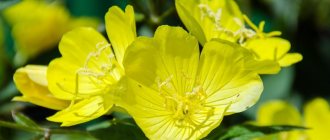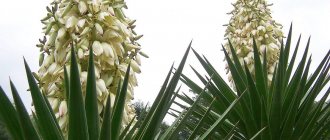Application in landscape design
Eveningweed looks very good when planted in groups in large areas. Its bright and tall inflorescences are very clearly visible at long distances. It looks great on the banks of artificial reservoirs, next to ornamental grasses or ferns. Its distinct scent (which is why it is nicknamed night violet) makes it ideal for creating fragrant gardens and butterfly gardens, as its leaves and stems are eaten by some types of caterpillars. It is very often planted in evening rest areas to enjoy this unique aroma, which intensifies in the evening.
Matrona's noctule is used in groups when creating tall flower beds, but one should take into account the fact that its leaves quickly lose their decorative effect, therefore, late-flowering annuals need to be planted nearby to hide this drawback. Night violet flowers can be used to make bouquets, and the plant itself is an excellent honey plant.
Hesperis stems contain up to 50% oils, which makes it possible to use it as cattle feed.
Night violet leaves and stems are used in folk medicine as a diaphoretic and diuretic.
In conclusion, it is worth noting that the closest relative of hesperis is ordinary cabbage and the night violet has nothing to do with the usual violets. They called it violet because of its pronounced aroma, and night, because in the evening this aroma intensifies sharply.
Planting
Fragrant beauty Korean abelia
Not all varieties of matthiola can be propagated by dividing the bush, but double varieties of plants can easily tolerate this. The main method is to plant seeds in the soil. You can pre-sow the seeds in pots for seedlings - this must be done in the first days of spring. Since noctule seeds have a high germination rate, it is recommended to plant them immediately in prepared soil.
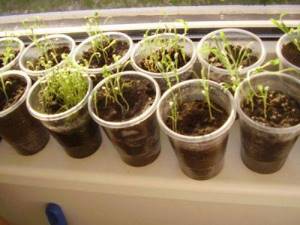
The appropriate period for sowing seeds in the soil is the end of spring - the beginning of summer, when it is still cool. Very small seeds need to be mixed with sand and sown in a designated place to a depth of one centimeter, evenly distributing them and not creating too much crowding. A good option for sowing flower seeds on the site is planting in individual bowls. This will make further weed control easier.
When planting seeds in the ground is completed, good moisture is necessary by spraying. Watering is not recommended - this can lead to erosion of the soil and loss of seeds. A protective film should be stretched over the moistened soil with the sown area. In the future, to ensure access to fresh air, it will need to be removed or lifted regularly.
To grow matthiola rosea seedlings in small containers, you need to prepare them first. Take some of the soil and pour it into the bottom of the flower pot, then sow the seeds evenly. Place a 0.5 cm thick layer containing peat and humus on top. Then you need to compact the soil composition a little, then sprinkle it with water. Moisturizing should not be too strong. After watering, place the container under glass or cover it with a film that can transmit light.
Place containers with seedlings in a warm room, maintaining the air temperature at 20 degrees, and water regularly. The first shoots will begin to appear on about the fifteenth day. After a month, you can already expect the first three leaves to appear, after which you need to start picking the seedlings. Then you need to water them generously and protect the plant sprouts from sunlight. If the sprouts of the noctule sprouts have sprouted very closely, then they need to be thinned out. Each sprout requires space with a diameter of 30 cm or more.
Matiola rosea (night violet): photo, cultivation, planting and care
How to grow seedlings
The most suitable time for sowing seedlings is the end of March - beginning of April. The seeds need to be planted in a box with soil, and the seedlings should then be transplanted, but you can use small cups for this at once, so as not to have to pick them later.
Seedlings should be grown in this order:
- First you need to prepare the soil with a rich content of organic fertilizers or buy a ready-made one that is suitable for night violets.
- The seeds are poured into the soil to a depth of about 1 cm.
- The distance between future shoots should be at least 2–3 cm.
- After the seedlings appear and the first leaves form on them, they must be transplanted into separate pots.
- For full growth, seedlings need to be provided with good lighting and regular watering.
- When the seedlings reach a length of 8–10 cm, they can be taken out into the open air or onto a balcony if the weather is not too cold.
- After 14–17 days, the seedlings can be transplanted into open ground.
To do this, young violets with a lump of earth on the roots are placed in pre-prepared holes and sprinkled with soil. The distance between them should be 25–35 cm. Then the seedlings must be well watered and continued to be cared for as adult plants.
Possible diseases and pests
Cinquefoil shrub yellow, white, pink
The health of the flower can be affected by regular waterlogging of the soil, which can lead to rotting of the roots. If there are obvious signs of any lesions on the leaves or inflorescences of plants, then such specimens must be disposed of immediately to avoid the spread of the disease.
In dry weather, cruciferous flea beetle may appear on flowers. Small holes in the leaves indicate her presence. To kill the insect, you need to finely crush the wood ash, then sprinkle it on the night violet and the ground around it.
Cabbage butterflies can also harm the plant. If they appear, it is recommended to treat the flowers with chemicals several times until the pests are completely eliminated.
Magnificent and unpretentious night violet when to plant and what soil to choose
Spider mites on indoor plants - how to fight
It’s clear that when we’ve already figured out the preferred places, it’s time to talk about the landing itself. Moreover, you need to understand that the night violet, a flower whose photo you can look at carefully, will not require you to spend excessive time and effort; it is so easy to grow and care for that it is preferable for most novice gardeners. However, even here there are a couple of fairly simple rules that must be followed in order for the night violet to produce abundant and fragrant flowers, the cultivation of which we are discussing.
- You should never plant matthiola or night violet, the photo of which is presented in all its glory, in those areas of your garden where cabbage or other cruciferous plants were previously grown. The thing is that they infect the ground with a certain fungus, which is not dangerous for other plants, but all your efforts to grow night violets can really come to naught. This tiny invisible enemy fungus is called clubroot, and it exclusively affects the roots of the plant.
- It is also worth thinking about the soil, which can be anything but acidic. The night violet, photos of whose flowers are abundant on the Internet, cannot tolerate excessively acidic soil. If you have circumstances that there is no other way, you will have to bring some soil from another place, or start reducing the acidity of the soil, which is quite dreary and far from easy.
- The seeds of night violet flowers, planting and caring for which do not require much effort, can be collected independently, and this will need to be done in the fall of each year. They can be found on the plant, they are hidden in special pods that need to be removed only after the first frost, and not before.
- The soil for planting matthiola needs to be prepared in the fall. It must be properly dug up, loosened and fertilized so that everything is ready for frost.
Night violet Matiola pink - photo, planting and care
General description of the genus
This genus includes annual and perennial herbaceous plants of the Cruciferous family. In nature, representatives of this genus are distributed throughout Southern Europe, the Mediterranean and surrounding regions.
All species and varieties belonging to the genus Matthiola have a number of common characteristics:
- plants have a single stem or form woody bushes covered with a felt edge;
- foliage is dense, pubescent, lanceolate, edge entire or serrated;
- flowers with four petals are available in a wide range of colors from white to yellow or lilac tones. Characterized by a sweet aroma. The flowers are collected in inflorescences - spike-shaped panicles;
- the fruit is a dry, flat pod with protruding tubercles from the seeds.
The evening smell attracts a large number of nocturnal insects that pollinate the flowers of the gillyflower.
Varieties
About 50 species of matthiola are known in nature . Thanks to breeding work, they gave rise to several hundred varieties.
The species that are most often used in ornamental gardening include the following.
Two-horned or night violet
Double-horned violet is an annual plant with an erect or branching stem, which is popularly called night violet .
Cold-resistant, unpretentious plant, can grow in partial shade.
Matthiola bicornuum pink.
Its features include:
- thin branched lodging stems reaching a length of up to 50 cm;
- inconspicuous flowers with a pale pink or purple color.
They are closed during the day and open only at night and in cloudy weather.
Gray-haired or left-haired
Cold-resistant annual , characterized by the following features:
- erect branched stem;
- flowers are simple or double, 3-7 cm in diameter, the inflorescence is a loose raceme;
- Fruit with seeds is produced only by non-double varieties of gillyflower. Terry varieties lack stamens and pistil, so no fruit is formed.
Mattiola gray-haired pink.
Important! In terms of the strength of the aroma, matthiola gray is significantly inferior to matthiola bicornuum.
Like night violet, gillyflower flowers are excellent honey plants.
Sowing and picking
Even a novice gardener who does not have sufficient experience working with perennial and biennial plants can cope with growing mattiola. To obtain healthy and strong flower seedlings, sowing seeds should be carried out in May according to the following scheme:
- It is necessary to make small furrows in the ground;
- The seeds are sown not too crowded and shallow;
- Then you need to spray the soil (without watering) so that the seeds do not wash away;
- The beds are covered with film, thereby creating greenhouse conditions for future seedlings;
- Periodically, the film must be removed to ventilate the soil.
You can sow matthiola seeds either directly into the ground or in bowls (carried out according to the same scheme). When weeds appear between seedlings, they must be removed in time so that the seedlings are not drowned out. If the soil is sufficiently warm, the gardener can expect sprouts to appear within a month after sowing the seeds in the ground. After this, you need to loosen the soil and moderate watering.

For seedlings that have already formed 3 true leaves, picking is used. It is enough to simply thin out the seedlings so that the diameter of the free space near each sprout reaches about 30 cm. After picking, it is recommended to water the plants abundantly and shade them from the sun's rays.
Types of noctule
Most cultivated varieties have simple flowers, but double flowers are also found. In gardens and parks you can find several unpretentious, but fragrant and attractive plant species.
Matron's Evening Violet
An ornamental plant that prefers loose soil. Blooms in the second year of life. Purple flowers are collected in large cylindrical racemes. They have a strong, persistent aroma. Flower diameter is up to 2 cm. Can be grown by direct sowing in the soil in May-June.
Hesperis Romance
A popular decorative biennial with single or double white flowers. The plant is characterized by a persistent pleasant aroma exuded at night. It prefers light areas, but also feels good in partial shade. Used for cutting and designing group flower beds and paths.
Hesperis Inspiration
Branched biennial with simple flowers of lilac, purple or white color, collected in brushes. Prefers slightly alkaline soils. The plant is suitable for planting in mixborders or gardens. Height 80-90 cm. Abundant fragrant inflorescences will decorate any bouquet. It is frost resistant.
Matron's Evening Crimson
An unpretentious flower known as night violet. The branched, erect stems are decorated with many crimson flowers. At night and in the evening, the biennial spreads a pleasant fragrance. Blooms from May to July. Looks great as a background plant for landscape style gardens. Seedlings are planted in June at a distance of 30 cm from each other. Can reproduce by self-sowing.
Evening night beauty
One of the most fragrant varieties of hesperis blooms in the second year after planting. Its flowers of a soft lilac hue are collected in beautiful large brushes. The plant is resistant to frost and disease. It grows to a height of 50-75 cm. The flower is suitable for cutting and is used in group and single plantings. Can be grown on the balcony.
Description: A wealthy official has a beautiful kept mistress. Once upon a time, an official pulled the girl Rita out of an underground brothel. The young woman is indeed very beautiful and it is not particularly clear how she even became involved in prostitution. The high rank liked the beauty, and he began to present her with substantial gifts. Over time, Rita got a car, an apartment, money and luxurious gifts. The loving representative of the authorities demanded only one thing in return, that Rita be faithful only to him and not even try to flirt on the side.
At first, the main character followed entirely and completely the basic requirement of her sponsor. This lasted until Rita met the man of her life. She just fell in love with a common man. Quite by chance she met Alexey, a student at Moscow State University. Even though he doesn’t have a lot of money, the girl really liked him. He has charm, beauty, an inquisitive mind and a fairly wealthy family. In addition, Alexey has a successful career ahead of him
A young student falls in love with Rita at first sight; it doesn’t matter to him who she was in the past or who she is now. The only thing he wants now is to marry Rita to himself and live a happy life
However, Rita's lover soon finds out about Alexei. In a rage, he takes away all of Rita's property, which he gave him. He takes away all the gifts, the apartment, the car and throws him out onto the street. Alexey invites the girl to live at his dacha. They plan to spend the whole summer here in the Moscow region, and then Alexey will find a job and they will move to the city, where they will rent an apartment.
Unexpected news ruins the calm life of a loving couple. Alexei's parents somehow found out that Rita was a prostitute in the past. While Alexei is leaving home, his father comes to visit Rita. An intelligent father asks the girl one thing, that she leave his son alone and go far away. According to her father, she will ruin Alexei’s whole life.
The conversation with Alexei’s father really touched Rita’s nerve. Late in the evening, when Alexey returned home, she told him that she no longer loved him and that she was returning to her influential lover. This behavior of his beloved girl shocked Alexei to the core. In his anger, he shouted at her to get away. Rita, silently collecting her things, left the house without saying a word about the conversation with her father and about her old illness.
Only a year later, Alexei’s hero learns the whole truth. He still loves Rita and hopes that everything will come to its senses. The series Night Violet will show you whether the main character can get his love back, watch online in good quality. The mini-series will premiere on the Ukrainian TV channel Inter on June 2. Don't miss the first episodes of the same day on our portal. Enjoy watching!
Flower name Night violet
Scientific
This amazing flower was well known to our ancestors. And not only among the people. But also among scientists:
Specific epithet
Large, long and pointed leaves near the roots complete its description. There are two of them. the species epithet Bifolia
speaks about Translated from Latin:
How to write correctly in Latin?
Night violet in Latin is Platanthera bifolia . Since 1817, it was named so by the famous orchid specialist Carl Linnaeus.
But that’s not the only way it was called, even in scientific circles. Just look at the different name for night violet:
Hesperis night violet for a beautiful garden
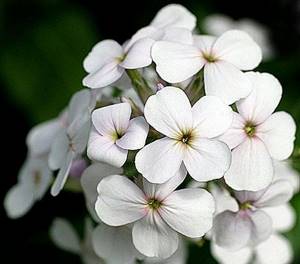
Plants form the same dense clumps with tall, erect stems, decorated with large lilac, pink or white inflorescences. But the simple corollas of phlox have five petals each, while hesperis, or night violet, as in the photo, has only four, which fully corresponds to the characteristics of plants from the cruciferous family. The species that came from Europe gained popularity in our country two centuries ago, and in France and the Mediterranean countries, hesperis became famous as an ornamental and medicinal plant back in the Middle Ages.
Group plantings of plants are especially beautiful, while growing violets does not require special skills and can be done even by beginners in floriculture. Unfortunately, recently, summer residents have lost interest in this culture, which once created a unique atmosphere in the landscape parks of Russian estates and country estates until the beginning of the 20th century.
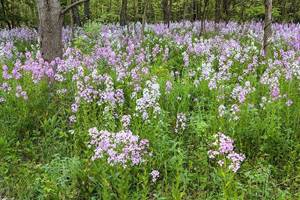
Under the name noctule, night violet or hesperis flower, it unites about 30 related subspecies, some of which have found a place in flower beds and parks. Some representatives of the species grow in Asia Minor and the Caucasus. Moreover, under favorable conditions, hesperis is a perennial herbaceous plant, found in the wild almost everywhere, from roadsides to forest edges and the banks of reservoirs.
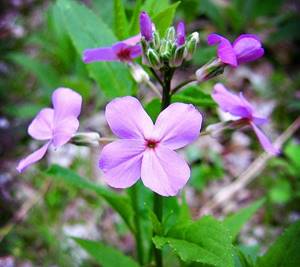
Covered with simple lanceolate leaves, the stems of hesperis reach a height of 90 cm. The foliage is pubescent with small sparse hairs and is attached to the shoots by short, strong petioles. The lower to the ground, the larger the size of the leaf plates, while the largest leaves can exceed 12 cm in length and reach 4 cm in width.
The inflorescences are quite dense, shaped like a brush or a cap. Flowers of all varieties of violets, as in the photo, open from the periphery to the center. In some cases, the length of the brush reaches 20–30 cm. The flowers themselves are small and symmetrical. The diameter of the corolla is from 1 to 2 cm.

The first buds open in May, and then hesperis blooms almost without interruption until mid-July. In place of the flowers, narrow oblong pods appear, in which small brown or brown seeds ripen. If the flower stalks are not cut off, the ripening seeds fall out and are capable of producing young shoots the following year.
How to properly care for violets so that the noctule will delight you with its blooms and intoxicating aroma? The plant needs light, well-drained soil to provide the crop with good nutrition. The best flowering is observed on slightly alkaline or neutral soil. During the period of growth and set of flowers, the night violet is provided with good watering, but do not forget that stagnation of moisture does not have the best effect on the plant. But even in the absence of water, one cannot expect abundant flowering.
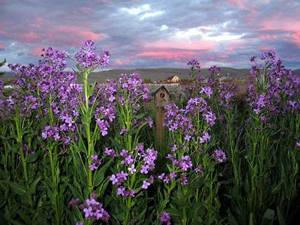
And yet, growing hesperis is very accessible and easy. For tall varieties of violets, as in the photo, they provide support. And for repeated flowering, you only need to promptly cut off the fading flower stalks that take away the strength of the plants.
Growing violets is similar to the agricultural technology of other biennials. Plants are propagated by seeds, which are sown as seedlings at home and then transplanted into the ground. It is also possible to sow in film greenhouses directly on the site, this will allow the seedlings to take root faster and more painlessly.
Shoots appear after 20–30 days, when the soil warms up to 18 degrees. Plants that have formed three true leaves are pruned and at the end of summer they are planted in a permanent place. By this time, the rosettes are fully formed and will easily survive the winter. It is better to leave an interval of 25-30 cm between night violet plants.
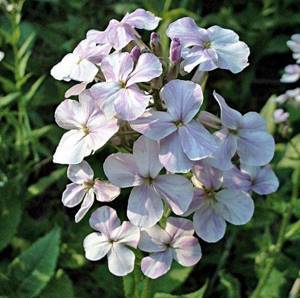
Wintering clumps, if there is not enough snow on the site, are covered with non-woven material or sprinkled with pine needles.
Growing night violet from seeds
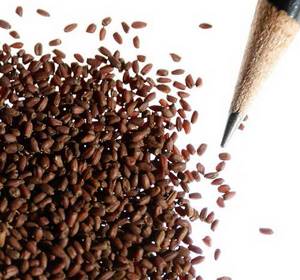
Night violet seeds photo Night violet growing from seeds when to plant
Agricultural holdings for seed production offer several options for the names of night violet: hesperis Matrona or nocturnal violet. There are single-color sets and color mixes. Some companies offer terry varieties. They are all equally beautiful and easy to care for.
How to plant night violet with seeds in open ground:
- planting seeds directly into the ground from May to October (autumn sowing will sprout immediately after the snow melts);
- sowing depth 1-2 cm in moist soil;
- transplantation is tolerated with great success; it is better to remove it from the ground with a small lump, without clearing the roots of the soil (this reduces the risk of drying out the root system);
- It is better to leave the distance between the bushes at least 30 cm, or 35-40.
- flowering usually occurs in the second year of life, but if you plant early, you can wait until the end of summer for the first buds;
- the fruits, brown-brown pods, produce offspring by self-sowing or specially organized sowing at any time.
- Seed ripening ranges from late August to September.
How to plant night violet seeds for seedlings:
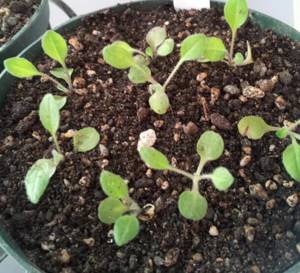
How to sow night violet photo of seedlings in a pot
When to plant night violet to obtain seedlings from seeds? Sowing time is from the twentieth of March to the beginning of April. The seeds are small, so most often gardeners sow them in boxes or containers, and then plant them in separate cups. You can tinker a little and plant 1-2 seeds in a cup, so that you don’t have to deal with picking the seedlings later. Here everyone decides for themselves what is more convenient.
- You need to prepare nutritious soil with an abundance of organic matter or buy a ready-made soil mixture for flowers and fill the containers.
- Seed placement depth is 0.5-1 cm.
- The distance is as small as possible, at least 2-3 cm between plants.
- When 2-3 true leaves appear, dense shoots dive into separate containers.
- Care consists of regular watering and providing good lighting; it is advisable not to place the plants in direct sunlight.
- When the seedlings reach a height of 8-10 cm, hardening begins: they take the containers outside, gradually increasing the duration of air-sun baths.
- After two weeks of hardening, the plants can be safely planted in open ground, the main thing is that there is no frost at night.
The wells are prepared in advance and spilled with water. Then the seedlings with a lump of earth are carefully removed and placed vertically in the hole, sprinkled with earth. Water generously. The distance between plants is 30-40 cm.
Night violet flower, ways to grow nocturnal flower, care, plant propagation
Since ancient times, plants that have a pleasant smell have been extremely popular among gardeners. Such plants include the night violet flower. Its peculiarity is its aromatic smell, which is especially noticeable in the evening and at night. The flower is also called matron's noctule. But the only thing they have in common is a pleasant aroma.
Night violet is also very similar in appearance to phlox, which is why it is also called “bull phlox.”
Belongs to the cruciferous family. It has oblong leaves, flowers are double or regular. Annual.
Growing night violet
Night violets are cultivated as an annual plant. Its stems can grow up to 80 cm over a season. The shoots, as a rule, are covered with narrow leaves. Depending on the variety, the plants are pubescent, smooth, silvery-gray or green. Terry varieties of night violet are especially attractive. The photo confirms this.
Growing night violet (evening violet) requires constant care. Weeds around young shoots must be carefully weeded out.
The seeds of the plant are contained in its fruit. The fruit is a pod reaching a length of up to 6 centimeters. The seed of the noctule remains viable for 3 years.
The nocturnal flower has several varieties.
The most popular varieties are:
Sowing is carried out directly in open ground, starting from April to June. The distance between the rows of matrons must be at least 10 centimeters. The seeds are lowered into the soil half a centimeter.
In greenhouse conditions, the seed can be sown in a pot, sprinkled with a layer of soil on top. The pot should be in a cool but well-lit place. Sprouts will appear quickly, then they are planted in open ground.
Night violet grows best in an open sunny place. This helps to increase its decorativeness. A year after planting, a dense rosette of leaves appears. A long and highly branching stem will appear only in the second year after planting.
Noctule seed can be added to the flower mixture. This will make the lawn even more attractive. You can clearly see what a night violet looks like in the photo.
Lighting
The noctule likes to grow in open, illuminated ground, but can thrive even in the shade of large trees.
Air humidity
Air humidity does not matter for violets. And slightly increased humidity will even promote active plant growth.
Air temperature
The noctule flower is considered cold-resistant. It can withstand temperatures down to minus 5 degrees C. Therefore, it often does not freeze out in winter. At high temperatures the plant also feels great.
Top dressing
The noctule plant is fed during flowering or active growth with complex mineral fertilizers. Lime must be added to the soil. Granular fertilizers are scattered around the bushes and covered lightly with soil when loosening it.
Transfer
The noctule tolerates transplantation well. But replanting is required in pre-moistened soil. Even during the flowering period, the flower tolerates transplantation well.
Reproduction
Noctule is propagated by seeds in late autumn or spring. The seed germinates on the 10th day. After two months, the night violet begins to bloom. Before sowing, you need to add drainage and fertilizer to the soil.
Vessel seedlings need to be thinned out. The terry species reproduces by dividing the bush. To extend the flowering period of the night violet, already faded inflorescences should be removed.
Night violet diseases
The following can cause harm to the plant:
Night violets in landscape design
In the garden, the night violet flower is planted along the paths. Vechernitsa is an excellent decor for an artificial pond. Vegetarian is also indispensable for creating flower beds and flower beds.
The photo shows how the nocturnal plant can be placed in places reserved for rest. Night violet looks great in flower arrangements.
Application
Night violet is used as a remedy in folk medicine.
Decoctions are prepared from the plant for treatment:
Vegetarian infusions are used as diaphoretics and diuretics. The plant helps in treating the respiratory tract.
An alcohol tincture from the leaves has an antibacterial effect and is indispensable for infectious diseases.
You can use sprouts of nocturnal seeds. They contain a lot of vitamin C and A, minerals iron, calcium, magnesium, phosphorus).
Night beauty violet
Reproduction of night violet
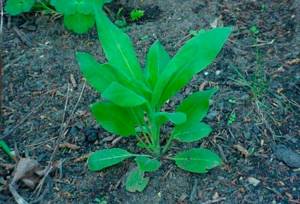
As mentioned above, night violet reproduces well by self-sowing, but, if desired, it can also be done by seedlings. To do this, you need to get containers for seedlings, and then pour soil into them. At the beginning of April, seeds are poured directly onto the surface of the ground and covered with a mixture of peat and humus, a layer of 0.5-1 cm. After this, the layer of peat and humus is slightly compacted and watered, after which the container with the sown seeds is covered with plastic film to create a greenhouse effect. After 2-3 weeks, at an ambient temperature of +20°C, the first shoots will appear.
Under optimal conditions and good moisture, young shoots will begin to actively grow and develop, and when the first 2-3 leaves appear, they can be transferred to the ground, into the open air. At the same time, it is necessary to constantly water them and loosen the soil to allow air to reach the roots of the plant. By the beginning of autumn, stems of night violet, densely dotted with leaves, form in the flowerbed. At the beginning of the next season, young plants will bloom profusely.
In order not to bother with seedlings, you can plant young plants after self-seeding and leave as many young plants as needed for propagation.
Seeds can be sown in the ground either in the spring, after the ground has completely thawed, or in the fall, before the first frost.
In the third year of life of hesperis, its attractiveness drops sharply, therefore, it is recommended to renew the crops every year. This means that it blooms most profusely in the second year of life. This is one of the significant disadvantages of growing night violets.
Biological description
Night violet is an unpretentious, modest flower belonging to the cabbage family. The wild species is widespread throughout the country. It grows mainly on the banks of reservoirs, open forest clearings, and the sides of roads. In appearance, the plant resembles paniculate phlox.
The height of the plant does not exceed 80 cm. The stems are erect with a branched upper part. Leaf blades of elongated lanceolate shape are located alternately on the stem. The surface is slightly pubescent with a few villi. The size of the leaves increases closer to the base of the stem.
Already in the second year of life the plant blooms. From the first days of May, “Vechernitsa” decorates the flower garden. Under favorable weather conditions, the flowering period is extended until early autumn. Small flowers with a diameter of 1.5-2 cm consist of four oval petals and are symmetrically attached to a long peduncle. Loose inflorescences of medium size have a racemose, less often spherical shape.
A variety of bright colors gives room for the imagination of gardeners and creates a riot of colors in the flower beds. The plant blooms with lilac, white or various shades of purple flowers. Regardless of color, all flowers emit a subtle, intoxicating aroma after dusk. At the end of flowering, the plant forms long, narrow fruit-pods with small brown seeds in place of the flowers.
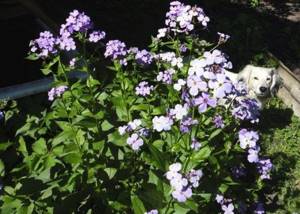
Common varieties of horned violet
Breeders are actively engaged in crossing and breeding new varieties of Viola cornuta. Many seed producers have divided hybrid forms into two groups:
- Cornuta - includes several variety series, among which Velor (10 colors) and Princess (7 colors) are popular.
- Viola x hybrida - the plants have a complex hybrid origin, but the basis is Viola cornuta. The most famous variety series: Sorbet (20 shades), Penny (15 shades).
Fans of perennial violets can choose single-color varieties (white, cream, blue), as well as two or three colors. When growing hybrids, you should remember that they tolerate frost less well. You should take care of shelter for the winter. Some varieties are biennials.
Viola "Molly Sanderson"
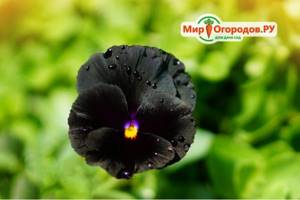
The original colors of the perennial will appeal to lovers of exotics. The flowers are black or purple with a yellow center. The bushes are low, up to 15 cm, spreading. The leaves are green and shiny. The variety is resistant to wintering; light shelter is sufficient. Used for planting in rock gardens, rock gardens, and mixborders. The beginning of flowering is April. Prefers shaded areas.
Horned violet "Rebecca"

This variety is valued for its abundant and long flowering. Grows up to 15 cm. Used for planting near coniferous and deciduous shrubs. As it grows, a lush mat with many leaves and flowers is formed. The color of the petals is light yellow with purple strokes along the edges. Flowering from June until the first frost. In summer it requires watering.
Viola "Foxbrook Cream"

A distinctive feature of the variety is the snow-white petals of violets. It is perfect for decorating the foreground of borders and flower beds. The perennial grows in partial shade and in open areas. Leaves are not cut off for the winter. Flowering from May to September.
Variety "Boughton Blue"
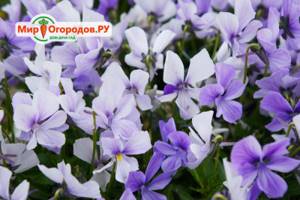
The bushes grow only up to 10 cm, but the pale blue flowers delight with beauty from March until frost. An unpretentious perennial suitable for planting in pots. Prefers light, moist soil.
Violet Viola Columbine
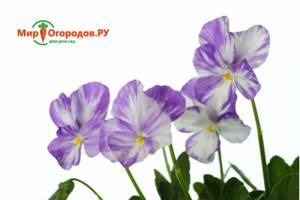
The stems of the creeping plant form turf up to 20 cm high. The leaves are green, oblong, with large teeth. Numerous flowers are variegated in color; their petals combine white, purple and blue. The plant needs loose, fertile soil. Flowering continues from May to October. In winters with little snow, it is recommended to cover with spruce branches.
Night violet in landscape design Photos of varieties
Hesperis, night violet, Matrona anemone - all this is the name of one beautiful plant. The bush received such a wonderful multifaceted name due to its wide distribution among the regions. In some regions there is another name - “bull phlox” for its comparison with phlox and its impressive size.
The combination of evening grass together with lupins is interesting, resulting in a fragrant plantation with special romanticism and unique lightness of compositions.
Hesperis matrona looks beautiful against the background of plantations of red tulips: the contrast of red and purple is very harmonious, quite bright, but does not irritate the eye with excessive variegation.
Planting hesperis together with irises is popular: large irises are perfectly shaded by noctule and a very harmonious composition is created.
The combination of Cosmos bipinnate with Hesperis matrona is unique. The bright scarlet inflorescences of cosmos look like fluttering moths against the backdrop of a solid carpet of night violet flowers. For gardeners, night violet will become an assistant in attracting pollinating insects.
Designers will appreciate the long flowering and rather large size of the bush. Florists will be able to decorate their bouquets; when cut, hesperis lasts a long time without losing its appearance
The purpose for planting the Matrona anemone on the site is not so important. The main thing is a beautiful appearance and a unique aroma.
The exact name of the flower Night violet
Many flower lovers often have to deal with their names.
Especially for beginners. Alone in everyday life and in conversations. And there are others on sale on labels. And you won’t remember right away.
But this is just the beginning. Then they are remembered. So it’s quite interesting with violets.
Violet (Viola) has been known and popular since ancient times. Greece, Rome. And it grows in numerous areas of the Northern Hemisphere with a temperate climate. There are fewer of them in apartments than in parks and gardens.
And in nature, some sources name about 500 species , while others even name more than 700:
Application
Beautiful, fragrant noctule is widely used by landscape designers and amateur flower growers. In addition, it has unique healing properties, therefore it has found its use in folk and official medicine.
Landscape use
Designers actively use Vechernitsa Matrona for landscaping. Their unpretentiousness and long flowering period make these flowers a desirable acquisition not only for private plots, but also for city squares.
Flower beds with fragrant flowers are located near gazebos, verandas, and garden paths. This allows you to enjoy not only modest beauty, but also a sweet floral fragrance.
Night violet looks especially beautiful in group plantings, forming bright spots on ridges, alpine hills or flower beds. The discreet beauty of the flowers looks good with various types of summer flowers and herbs. The combination with the following plants looks impressive:
- petunia;
- chamomile;
- marigold;
- lavender;
- cornflower;
- fern.
Single plants refresh meadow and Moorish lawns well. The long, slender stems are great for cutting into field bouquets. Cut flowers remain fresh for up to 1.5 weeks.

Use in medicine
Almost all parts of the plant - stems, leaves, flowers, seeds - have healing properties. The plant is richest in essential oils, flavonoids, saponins, vitamins A, C, as well as microelements:
- phosphorus;
- magnesium;
- potassium;
- iron.
Decoctions of the leaves are used as a natural diaphoretic. Raw and dried flowers contain large amounts of vitamin C. Therefore, flower decoctions are a good vitamin remedy. Sprouted seeds improve appetite, restore the body's resources, and fight flatulence.




